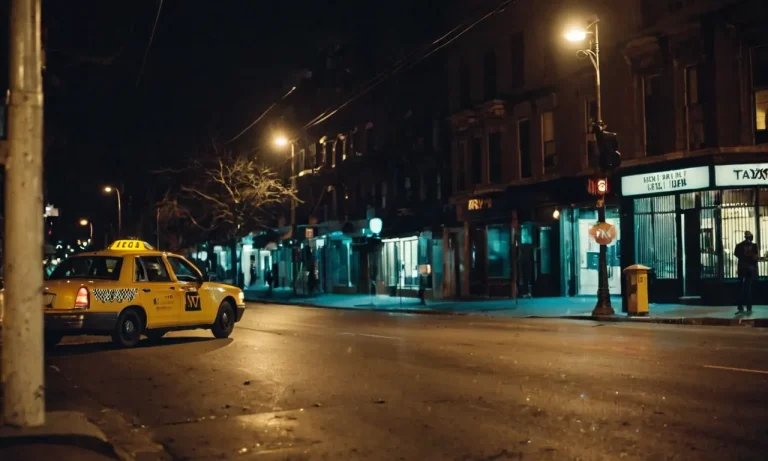Is It Cheaper To Take A Taxi Or Uber In Nyc In 2023?
With rising prices across the board, New Yorkers are looking to stretch their dollar as far as it can go when getting around the Big Apple. If you’re wondering whether traditional yellow taxis or rideshare services like Uber offer better value, you’re not alone.
If you’re short on time, here’s the quick answer: Uber tends to be cheaper than taxis in NYC, but taxis can sometimes be the more affordable option for shorter trips.
In this comprehensive guide, we’ll look at the factors that impact the cost of both taxis and Uber in NYC, including base fares, per mile rates, surge pricing, tolls, tipping, and more. We’ll crunch the numbers to show sample trips in different parts of the city, so you can get a clear sense of when Uber beats taxis on cost and vice versa.
How Taxi Fares Are Calculated in NYC
Base Fare
When you hop into a taxi in NYC, the first charge you’ll see on the meter is the base fare. As of 2023, the base fare for a yellow taxi in NYC is $2.50. This initial charge covers the first 1/5 mile of your journey.
Keep in mind that different types of taxis, such as green cabs, may have different base fares.
Per mile/minute rates
After the base fare, the meter in a NYC taxi calculates the charge based on both distance and time. As of 2023, the per mile rate for yellow taxis in NYC is $2.80. This means that for every mile you travel, you’ll be charged $2.80.
Additionally, there is a per minute rate of $0.50 for the time spent in slow or stopped traffic. These rates can vary for other types of taxis, so it’s important to check the current rates.
Peak hour surcharges
During peak hours, which are typically from Monday to Friday between 4 PM and 8 PM, an additional surcharge of $1 is added to the metered fare. This surcharge helps offset the increased demand for taxis during these busy times.
It’s important to keep this surcharge in mind when calculating the cost of your taxi ride, especially if you’re traveling during peak hours.
Tolls & extras
In addition to the base fare and per mile/minute rates, you may also need to pay for any tolls incurred during your taxi ride. If your route includes toll bridges or tunnels, the driver will add the toll amount to the final fare.
It’s important to note that the passenger is responsible for paying the tolls. Additionally, if you have any bulky items or pets with you, there may be additional charges for these extras.
For more detailed information on taxi fares in NYC, you can visit the official website of the New York City Taxi and Limousine Commission.
How Uber Fares Are Calculated in NYC
When it comes to calculating fares, Uber in NYC follows a specific set of guidelines. Understanding how Uber fares are determined can help passengers make informed decisions and compare the cost of taking an Uber versus a traditional taxi.
Here are the key factors that contribute to the calculation of Uber fares in NYC:
Base fare
Uber charges a base fare for every ride, which covers the initial cost of the trip. The base fare may vary depending on the type of Uber service chosen, such as UberX or Uber Black. It is important to note that the base fare does not include additional costs like tolls or surge pricing.
Per mile/minute rates
In addition to the base fare, Uber calculates fares based on the distance traveled and the time spent in the vehicle. The per mile rate accounts for the distance covered, while the per minute rate takes into consideration the time spent in traffic or waiting at red lights.
These rates may differ for different Uber services.
Surge pricing
During periods of high demand, Uber implements surge pricing, which increases the fare to incentivize more drivers to get on the road. Surge pricing is dynamic and can change rapidly based on factors like the time of day, weather conditions, and local events.
This means that fares can vary significantly during peak times.
Tolls & fees
If your Uber route requires passing through tolls or incurs additional fees, such as airport pickup fees, those charges will be added to the fare. Passengers are responsible for covering these costs, which are separate from the base fare and per mile/minute rates.
It’s worth mentioning that Uber fare calculations can be complex, and slight variations may occur based on factors such as traffic conditions and route deviations. To get a more accurate estimate of the cost, passengers can use the fare estimation feature on the Uber app before confirming their ride.
For more information on Uber fares in NYC, you can visit the official Uber website at https://www.uber.com/cities/new-york-city/.
Taxi vs. Uber Cost Comparison for Sample Trips
When it comes to getting around in New York City, there are many transportation options available. Two of the most popular choices are taxis and Uber. Both offer convenient and reliable rides, but which one is cheaper? Let’s compare the costs for different types of trips.
Short trips (under 2 miles)
For short distances, taking a taxi or an Uber can be a quick and affordable option. Taxis in NYC have a base fare of $2.50, plus an additional $0.50 per 1/5 mile or 60 seconds of waiting time. On the other hand, Uber has a base fare of $2.55, with an additional $0.35 per minute and $1.75 per mile.
Based on these rates, if you’re traveling less than 2 miles, it’s likely that both taxis and Uber will cost you a similar amount. However, it’s worth noting that Uber sometimes offers promotional discounts or surge pricing during busy times, which can affect the overall cost.
Medium trips (5-7 miles)
For medium-distance trips, the cost comparison between taxis and Uber becomes more significant. Taxis charge the same base fare and per mile rate as for short trips, but the waiting time charges can add up if you encounter traffic.
Uber, on the other hand, has a fixed per minute and per mile rate, which can make it more cost-effective for medium-distance trips. Additionally, Uber often provides fare estimates upfront, allowing you to know the exact cost before you book a ride.
Long trips (10+ miles)
When it comes to longer distances, Uber tends to be the cheaper option compared to taxis. Taxis charge the same base fare and per mile rate as for short and medium trips, but the overall cost can quickly escalate due to waiting time charges and traffic delays.
Uber, on the other hand, offers fixed rates for longer trips, which can help you save money. Plus, with Uber, you have the option to choose different types of vehicles, such as UberX or UberXL, which can provide more comfort and space for your journey.
Trips with tolls
If your trip involves tolls, it’s essential to consider the additional charges imposed by both taxis and Uber. Taxis charge the cost of tolls on top of the metered fare, while Uber may include tolls in the upfront fare estimate.
However, it’s worth noting that some Uber services, like UberPOOL, may not include tolls in the upfront estimate, so it’s important to double-check before booking your ride.
Factors Impacting Costs for Taxis vs. Uber
When it comes to choosing between a taxi and Uber in NYC, there are several factors that can impact the costs. Understanding these factors can help you make an informed decision and potentially save some money. The following are some key factors to consider:
Surge Pricing
One significant factor that can affect the cost of both taxis and Uber rides is surge pricing. Surge pricing occurs during high demand periods when prices are increased to encourage more drivers to be available. Both taxis and Uber implement surge pricing, but the way they calculate it may vary.
Uber typically displays surge pricing on the app, allowing you to decide whether to accept the higher fare or wait for prices to decrease. Taxis, on the other hand, may not have a clear indication of surge pricing, so it’s essential to be aware of this factor when making your decision.
Tipping
Tipping is another factor that can impact the total cost of your ride. In NYC, it is customary to tip both taxi drivers and Uber drivers. However, the tipping process may differ between the two. With taxis, it is common to tip around 15-20% of the fare, while with Uber, you can add a tip directly through the app.
Some passengers may find it more convenient to tip through the app, while others prefer to give cash directly to the taxi driver. Consider your tipping preference when calculating the overall cost of your ride.
Time of Day
The time of day can also play a role in the cost difference between taxis and Uber. During peak hours, such as rush hour or late at night, both taxis and Uber may have higher fares due to increased demand. However, the extent of the price difference can vary.
It’s always a good idea to compare the prices on the app or hail a taxi to see which option is more cost-effective at that specific time.
Location
The location of your pick-up and drop-off points can impact the cost of your ride. Both taxis and Uber may have different pricing structures depending on the zone or borough you are in. For example, taking a taxi from Manhattan to Brooklyn may have a different fare compared to an Uber ride for the same distance.
It’s worth comparing the prices for your specific route to determine which option is more affordable.
It’s important to note that factors impacting costs for taxis and Uber can vary over time. It’s always a good idea to check current rates and compare them using the respective apps or websites of taxi companies and Uber.
Other Considerations When Choosing Taxis vs. Uber
Convenience & availability
When it comes to convenience and availability, both taxis and Uber have their pros and cons. Taxis are a familiar sight on the streets of New York City, and you can easily hail one down when you need a ride. They are also readily available at taxi stands throughout the city.
On the other hand, Uber offers the convenience of requesting a ride through a mobile app, which can be particularly useful during peak hours or when taxis are scarce. Additionally, Uber often has a larger fleet of vehicles, which means shorter wait times in some cases.
Payment options
When it comes to payment options, Uber takes the lead. With Uber, you can easily link your credit card or PayPal account to the app, so you don’t have to worry about carrying cash or dealing with the hassle of splitting the fare.
Taxis, on the other hand, still primarily accept cash, although many are starting to accept credit cards as well. However, there may be additional fees or surcharges when paying with a card in a taxi. It’s important to consider your preferred method of payment when deciding between taxis and Uber.
Safety & accessibility
Safety and accessibility are important factors to consider when choosing between taxis and Uber. Both taxis and Uber drivers are required to meet certain safety standards, but Uber has implemented additional safety features such as GPS tracking, driver ratings, and the ability to share your trip details with friends or family.
This can provide an extra level of comfort and security for passengers. In terms of accessibility, Uber often has more options for riders with disabilities, including wheelchair-accessible vehicles. However, taxis are also required to provide accessible transportation options.
When it comes to choosing between taxis and Uber in NYC, it ultimately depends on your personal preferences and priorities. Both options have their advantages and disadvantages. If convenience and availability are your top concerns, Uber might be the better choice.
If you prefer to pay with cash or want the reassurance of a yellow cab, a taxi might be more suitable. Whichever option you choose, both taxis and Uber can provide a reliable and convenient way to get around the city.
Conclusion
With rideshare services continuing to evolve in New York and traditional taxis facing more competition than ever, there’s no one-size-fits-all answer to whether Uber or taxis are cheaper in NYC in 2023.
However, by understanding how pricing works for both options and the main factors that drive costs up or down, you can make an informed decision for each ride. Generally speaking, UberX tends to beat taxis on cost for longer trips, while taxis can be cheaper for shorter hops.
But surge pricing, tipping, tolls and other variables also impact the math. Hopefully this breakdown gives you what you need to get around NYC affordably using the option best suited for each journey.








